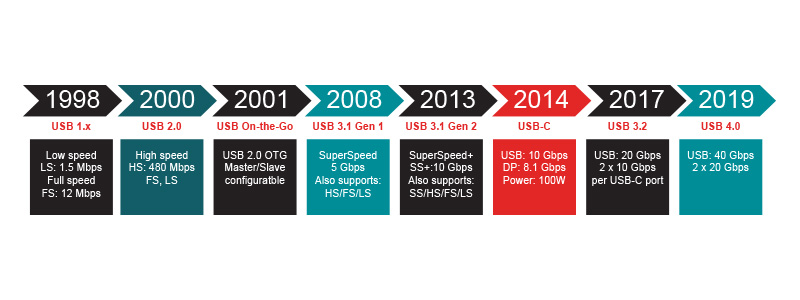SSZT267 july 2020 TUSB1002A , TUSB1042I , TUSB1064 , TUSB1146 , TUSB216 , TUSB4041I , TUSB542 , TUSB8041A , TUSB8042A , TUSB9261
- 1
-
2
- 3
- 1: What are the interface capabilities of your CPU or MCU?
- 2: How do you transmit data over a long distance when your interface’s data link reliability is lacking?
- 3: What if your MCU or CPU has only one instance of the USB interface?
- 4: What if your CPU or MCU interface has limited interface options?
- 5: Do all USB connections require external connections?
- 6: What if you need more flexibility than what standard USB connections provide?
- Additional resources
Designing a system that uses high-speed signals for data transmission can be difficult, especially when there are so many available communication protocols. While many are ideal for high-speed signals, one in particular continues to grow in popularity – the USB. Often been associated with gaming, automotive head unit, and PC and notebook applications, the USB protocol has become a more general-purpose high-speed data protocol, connector and cable specification due to its support for multiple types of data transfers and high-power charging. Figure 1 shows the evolution of USB since it's release in 1998.
 Figure 1 The History of the USB
Protocol through Release of USB 4.0 in 2019
Figure 1 The History of the USB
Protocol through Release of USB 4.0 in 2019To help you understand whether the USB protocol is a good fit for your system and meets your high-speed interface needs, here are six key questions designers should consider.
1: What are the interface capabilities of your CPU or MCU?
When working with USB, it’s important to first consider the interface capabilities of your central processing unit (CPU) or microcontroller (MCU), as this device is fundamental for high-speed data transfer in your design. If you find that you need to transmit data from a CPU or MCU to a connected peripheral with a data rate greater than 10 Mbps, USB can be a great fit.
2: How do you transmit data over a long distance when your interface’s data link reliability is lacking?
USB could replace this connection with an existing integrated circuit solution for extending your interface’s communication abilities. USB redrivers help maintain signal integrity while transmitting over long distances. Devices like the TUSB216 (USB 2.0) and TUSB1002A (USB 3.0) include features specific to the USB protocol that ease the implementation of redrivers in USB.
3: What if your MCU or CPU has only one instance of the USB interface?
The USB includes devices called USB hubs that can turn one port into multiple ports with minimal effort. Four-port high-speed USB hubs such as the TUSB4041I, TUSB8041A and TUSB8042A can help increase the number of devices that can be used at once.
4: What if your CPU or MCU interface has limited interface options?
USB solutions have progressed, enabling conversion to other interfaces like universal asynchronous receiver-transmitter (UART) or Serial Advanced Technology Attachment (SATA). USB bridges enable the conversion of USB to UART and SATA. If your MCU or CPU does not have an interface to UART or SATA, or if the transmission distance is too great for plain UART or SATA interfaces, consider USB bridges like the TUSB9261.
5: Do all USB connections require external connections?
While you may see external USB ports everywhere in consumer products, USB connections do not have to be external. If your chosen MCU or CPU has USB capability, you can also consider USB for embedded connections to other MCUs or CPUs in your system. USB has built-in data encoding to help reduce electromagnetic interference and link power management for power efficiency. USB also adds flexibility for customer software where many low-level drivers already exist today.
6: What if you need more flexibility than what standard USB connections provide?
The introduction of the USB Type-C® protocol has greatly increased USB’s flexibility. USB Type-C enables the creation of peripherals that act as a USB host or USB device, enabling systems to react to different kinds of connections in multiple ways. USB Type-C active multiplexers can also help ensure the correct configuration of the interface while providing signal integrity compliance to the USB specification.
For technical details on the USB protocol and USB implementations, check out the resources below, or post on the TI E2ETM Interface forum if you have a technical question about USB and need help picking the correct product for your system.
Additional resources
- “The ultra-low-power USB revolution: Bringing power efficiency and simplicity to USB for portable embedded applications.”
- “USB Type-C and USB Power Delivery power path design considerations.”
- “A primer on USB Type-C and Power Delivery applications and requirements.”
- “Alternate Mode for USB Type-C: Going beyond USB.”